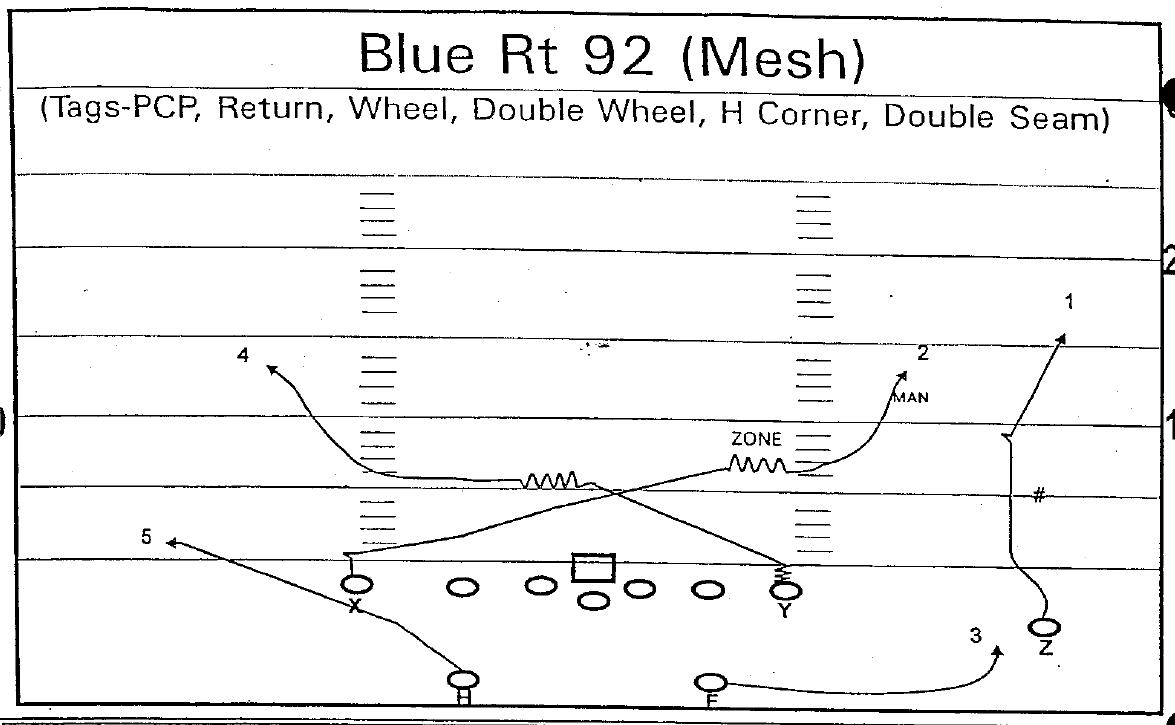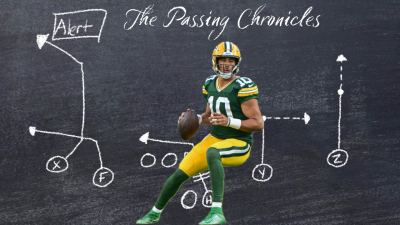The Passing Chronicles: Mesh in 2020
By DustyEvely

If you’ve been reading me for any time at all, you know of my deep love of the Mesh concept. And, while we’ve been over it before, let’s revisit the genesis and key components.
It is believed to have been created under LaVell Edwards’ watch at BYU, possibly by Offensive Coordinator Doug Scovil. The concept became an obsession for Hal Mumme, who eventually made it one of the key pieces in his Air Raid system. Most of the world knows it as Mesh, but Mumme – always one to make things as simple as possible – simply called it “92”.

As with a lot of concepts, there are a thousand ways to run Mesh. Some people define it as the two drag patterns crossing in the middle of the field. And, while that is the center of the concept, Mesh generally has all 5 eligible receivers. Here are the general route groupings you tend to see on this concept:
- Two crossing drag routes, generally 3-7 yards downfield
- Crossing route over the mesh point of the drag routes (curl, dig or over)
- A vertical route from the outside (go, post or corner)
- Flat route under the vertical route (typically from the backfield)
At least, that’s how the traditional Mesh concept tends to look. The dueling drag routes create chaos in the middle, the crosser takes advantage of the chaos and the vertical/flat combination stresses the defense with a vertical stretch.
As you may have guessed, the Packers don’t run it this specific way very often. Running it from groupings other than a single-back set prevents the use of some of those routes. The route that was eliminated the most was the flat/swing route. While they did throw to that route 7 times, it was the route that was usually left out. The Packers instead opted for a route to work behind the crossing route, or a second mesh point 5-10 yards deeper with dueling crossing routes.
Mesh was a popular concept for the Packers in 2020. By my count, they ran it 37 times, which averages out to slightly more than twice per game. It was productive as well, averaging 8.1 yards per attempt.
They liked to run it based on defensive match-up. The mesh point can be disruptive against man coverage, as it can create a natural pick against the defenders attempting to follow those receivers. So it shouldn’t surprise anyone that the Lions – a team famous for playing man defense almost exclusively under Matt Patricia – was the Packers #1 target. In their two meetings, they ran this concept 12 times against the Lions, averaging 9.2 yards per attempt.
To get a deeper look at this concept, I wanted to break down where the throws went, using the route groupings from above as our guide. There were 2 sacks on this concept and 1 QB scramble. For the purposes of our groupings, we’re only going to look at the plays that resulted in an attempted pass (34 pass attempts)
You ready? I’m ready. Let’s party.
Drag
Throwing to one of the dueling drag routes was the most popular targeted route. This route was targeted 17 times (50%) and averaged 8.3 yards per attempt.
Mumme taught this concept with the drag routes as the third read in the progression (after the vertical and flat), but, because of how it can stress the middle of the defense, the bulk of the throws tend to go to these routes. Against man coverage, the crossing drag routes can knock coverage off one of the routes, giving him a free run through the middle of the field and releasing out the other side. Against zone coverage, the defenders will often widen in the middle of the field, giving a window on the drag route underneath. While Mesh can work against zone, it is more effective against man coverage.
The Lions are in man coverage – surprise surprise – with Jamaal Williams [30] matched-up on a linebacker. All the chaos in the middle causes a couple different levels for the defender to run over/fight through. While he’s doing that, Williams is wide open on the drag for an easy 22 yards.
Flat
The flat route was targeted 7 times (21%) and picked up an average of 4.4 yards per attempt, the lowest average yardage of all the routes. That’s not really surprising, seeing as how it’s the only route that starts behind the line of scrimmage.
Sometimes this route works as a checkdown, while other times it works as an immediate swing pass based on the defensive numbers.
The flat route was the most targeted route in this concept when run in the Red Zone. The Packers ran Mesh 7 times in the Red Zone and the flat route was the target on 3 of those, averaging 4.3 yards per attempt and notching 1 TD.
The Packers are in a condensed formation, so the right side of the field is nothing but grass. The Bucs are showing man coverage pre-snap, putting Williams on a linebacker. With two routes releasing off the right side of the line, Aaron Rodgers reads the linebacker across from Williams to make sure he’s the man in coverage. He is, indeed, the man in coverage. While the linebacker has to sift through the mess, Rodgers flips it over to Williams for a wide open swing pass. Nice pick-up of 11 on 3rd & 2.
Vertical
As I mentioned earlier, this is typically the first read on this concept. It’s a pre-snap read and an immediate post-snap look. If the quarterback likes the initial look, he’ll throw this. It’s typically covered up, so you don’t see a ton of throws on this route, but it’s always there as a potential deep shot and a way to take the top off the defense.
In 2020, they threw to this route 6 times (18%) for 16.7 yards per attempt and 2 TDs.
With the strongside of the offense reestablished after the motion, the safety shifts to Davante Adams’ [17] side pre-snap, but then immediately starts sneaking down over the slot receiver, as the slot corner is showing blitz. That would leave the 49ers with no deep safeties, putting Adams in a one-on-one match-up on the outside, so that’s where Rodgers is looking.
At the snap, both safeties back off, showing a two-deep look. Adams runs a stutter-and-go. Rodgers pumps on the stutter of Adams. With it being 3rd & 7, the 49ers are looking for something at the sticks. The safety crashes on the pump fake and Rodgers goes over the top for 49 yards; the longest gain from the Mesh concept in 2020.
Crosser
The Crosser is the route that is most interesting to me, because of the different ways it can be run against the coverage. It was the one targeted the least by the Packers, often acting as an outlet option. Against zone, a curl route can work particularly well, as it allows the receiver to settle into a hole in the zone as the structure of the defense begins to deteriorate. The crossing route was thrown to 4 times (12%) and averaged 10.5 yards per attempt.
Of the crossing routes, the curl route over the mesh point was the most productive. It accounted for 3 of the 4 targets, averaged 14 yards per attempt and picked up 1 TD.
The Bucs are in a match-zone look. When Allen Lazard [13] releases horizontally, the boundary defender who was initially matched-up on him drops into a deep zone. That leaves 3 receivers on 2 defenders. The middle of the Bucs defense does a good job of sifting and passing off routes, but they’re still a man short. The drag routes pull the defenders wide and Lazard settles into the middle.
A common variation of Mesh is having the drag routes look like they’re going to cross in the middle of the field, then reverse course and head toward the sideline. It can be a good way to catch the defense in a switch, or help spread the middle of the field for the crossing route.
The Lions have two linebackers in the middle of the field. The Packers send the mesh look, then pivot the routes back to the sideline. The linebackers follow and Robert Tonyan [85] finds space in the middle. He keeps drifting slightly away from one of the linebackers to give Rodgers a nice throwing lane, and Rodgers eventually hits him for 11 yards on 3rd & 3.
While we’re here, I do want to talk about the different ways the Packers ran the crossing route. While the curl route over the mesh point was the most popular option (they ran that route on 50% of Mesh), they had 4 other ways to run that route as well. In addition to the curl, they also ran a dig route (24%), a deep over route (12%), a vertical route (9%) and a post/corner route (3%).
Though they didn’t hit the crossing route very often, it remains my favorite due to the versatility. The constant use of the curl route can lull defenses to sleep, opening up the potential of a big play by using a post/corner route. Adding an option to the crossing route can allow offenses to take advantage of the deep coverage on the play. Against a single-high safety, the route can continue as a deep over route across the face of the safety. Against two-high safeties, the route can bend up the field, taking advantage of the void in the deep coverage.
Mesh is a big part of most offenses at this point, and that’s certainly no different in Green Bay. The Packers have been using this concept for as long as I’ve been digging into their offense. I don’t know that I’ve ever seen them run it quite as well as they did this past year, though. It is a productive concept for this offense that can be absolutely lethal at times.
Football Outsiders defines a successful play as one that picks up at least 45% of yards needed on 1st down, 60% of yards needed on 2nd down and 100% of yards needed on 3rd & 4th down. By that metric, the Packers were wildly successful across the board.

Before we go, here’s a random smattering of numbers:
- The Lions take the cake in terms of number of times the Packers ran it against but against teams with more than 1 attempt, the Packers had the highest yards per attempt against the 49ers. They ran this 3 times in the Week 9 match-up and picked up 56 yards (18.7 YPA). Sample size matters, of course, as they picked up 49 of the yards on a single play.
- The Packers most popular personnel grouping was 11 personnel (1 RB, 1 TE, 3 WR). They used that personnel grouping 21 times (58%) and averaged 6.6 yards per attempt.
- Their most productive personnel grouping was 12 personnel (1 TB, 2 TE, 2 WR). They used that grouping 10 times (28%) and averaged 11.2 yards per attempt.
- This play was run exclusively out of shotgun and did not feature a single instance of play action or jet motion.
- The Packers ran this concept out of spread and compressed formations, but found more success in the spread. They ran it out of spread 20 times (56%) and averaged 10.8 yards per attempt. Out of compressed formations, they averaged 5.0 yards per attempt.
- Against 4 or fewer rushers, they averaged 7.1 yards per attempt. Against 5 or more rushers, they averaged 10.3 yards per attempt. The 2 sacks against this concept both happened against a 4 man rush.
- Their most productive formation was an empty backfield formation in a 3X2 alignment (3 eligible receivers to one side, 2 eligible receivers to the other). They ran Mesh out of that formation 7 times and averaged 12.7 yards per attempt.
- In that 3X2 alignment, their best personnel grouping was 12 personnel (1 RB, 1 TE, 3 WR). They ran that specific grouping 2 times, averaging 17 yards per attempt.
- They ran Mesh 7 times in the Red Zone, picking up 3 TDs. The TDs were thrown to the crossing route, flat route and vertical route. The only route in the Red Zone to not pick up a TD was the drag route.
Albums listened to: Olivia Rodrigo – SOUR; Brian Fallon – Local Honey; Ride – Nowhere; Deftones – Ohms; Rush – Moving Pictures; Lissie – Thank You To the Flowers; The 1975 – Notes on a Conditional Form; Title Fight – Hyperview; Ringo Deathstarr – Ringo Deathstarr; HY-FY – Awakening; Starflyer 59 – Miami; Jonsi – Shiver; Fire in the Radio – Monuments; Eric & Magill – Poor Moths; Gleemer – Down Through; Bleachers – Strange Desire; Frightened Rabbit – Painting of a Panic Attack; My Bloody Valentine – mbv; Sonic Youth – Daydream Nation
PLEASE SUBSCRIBE TO OUR CHEESEHEAD NATION WEEKLY NEWSLETTER HERE.
__________________________
Dusty Evely is a film analyst for Cheesehead TV. He can be heard talking about the Packers on Pack-A-Day Podcast. He can be found on Twitter at @DustyEvely or email at [email protected].
__________________________













Comments (7)
Coldworld
August 04, 2021 at 03:42 pm
Whether it’s Amari or Cobb, how do you think that the presence of a dedicated slot might impact how and how often we use these types of play?
mattgsx
August 05, 2021 at 11:53 am
I'm no film expert, but I'm guessing we will still see this a LOT, possibly with more throws going to one of those crossing routes. I would think either receiver could fly into and then break out of traffic, or be your flat option. Might even see a variation where you have a slot receiver and tight end both show the cross/drag but then have the TE break and turn upfield to try to block out the deep safety and give the slot receiver some more room to move.
mattgsx
August 06, 2021 at 10:51 am
Dupe
Turophile
August 04, 2021 at 04:31 pm
Dusty, since the mesh concept is used more against man coverage than zone, which of the first 4 teams the Packers face this year (Saints/Lions/49ers/Steelers), is most suited to mesh plays. Note that Patricia is no longer with the Lions .
Leatherhead
August 04, 2021 at 07:52 pm
We went 4-0 against those teams last year and scored 144 points (38 ppg).
PeteK
August 05, 2021 at 09:28 am
Looking at all those patterns I came away with two thoughts: a hefty amount of practice time is needed to get all the timing down successfully and now we know why good CBs are paid well.
mattgsx
August 05, 2021 at 12:55 pm
Love these reviews and cutups, Dusty! In a post where you previously discussed the mesh you said it was originally practiced so the WRs could high-five each other at the crossing point, but the Packers don't run nearly that tight. Is that by design to avoid an OPI call, intentional to try to pick the defenders into each other in that dead space, or just a result of guys running different speeds?